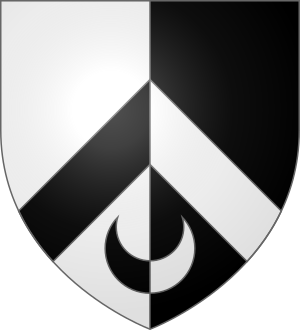Alexanders of Menstrie facts for kids
The Alexanders of Menstrie are a famous Scottish family. They are also known as the House of Alexander. This family is part of Clan MacAlister. People say they come from Somerled, a powerful leader from long ago. Their main home was Menstrie Castle in Menstrie, Scotland. Many Alexanders from this family later became important in Ireland, England, and the United States.
Contents
A Famous Scottish Family
The Alexanders of Menstrie became well-known in the 1600s. This was thanks to William Alexander, 1st Earl of Stirling. He was a poet and a close friend of King James VI. In 1604, the King made him a knight.
William Alexander received a special grant in 1621. This allowed him to start a new colony called Nova Scotia in North America. Later, in 1630, he became a Viscount. When King Charles I became king in 1633, William Alexander received even more honors. He was made the Earl of Stirling and Viscount of Canada.
He was also given large areas of land in North America. This included all of what would become Canada and Nova Scotia. It also included parts of New England, like Long Island. However, his direct male family line ended in 1739. Since then, many people have tried to claim his titles and lands. But none of these claims were ever officially proven.
Where Did They Come From?
There are different ideas about where the Alexanders of Menstrie came from. William Alexander, 1st Earl of Stirling wrote about his family history. He said his family came from Somerled, Lord of the Isles. Somerled was a powerful Scottish leader who died in 1164.
William Alexander believed his family descended from John of Islay, Lord of the Isles. John was the 7th Lord of the Isles. According to this story, John's son, Alexander MacDonald, was given land in Menstrie. This land was in Stirlingshire. His descendants then started using the English name "Alexander" as their family name.
Another old book from 1767, The Peerage of Scotland, tells a similar story. It says that Alexander MacDonald, son of the Lord of the Isles, received the Menstrie land. From him, the family took their name. Some also say the original family name was "Alschoner." This was a changed form of "Alexanderson." The Alschoners supposedly moved to Stirlingshire in the 1300s.
However, a well-respected historian, Sir James Balfour Paul, disagreed. He said there was no proof for these stories. He noted that the Alexander name appeared in many parts of Scotland. It was especially common in eastern Scotland.
The 1500s
According to Balfour Paul, the first record of an Alexander of Menstrie was Thomas Alexander. This was around 1505 or 1506. Thomas was involved in a land dispute. It is not known how Thomas Alexander got the Menstrie land. But it is known that the land belonged to the Earl of Argyll. In 1518, Thomas Alexander was a tenant in Tullibody, near Menstrie.
In 1526, Colin Campbell, 3rd Earl of Argyll gave land in Menstrie to Andrew Alexander. Andrew was likely Thomas's son. The land was also given to Andrew's wife, Catherine Graham. Their son, Alexander Alexander, would inherit it later. In 1529, the Earl of Argyll made "Alexander Alsynder de Menstrie" a special officer. This officer managed Argyll's lands in Clackmannanshire.
Over the next few years, Alexander and his family received more land. This included land in Menstrie and Perthshire. He was also called "Alexander Alschender" and "Alschoner" of Menstrie. He passed away in the 1550s. His son, William Alexander, took over. William died around 1574. William's son, also named Alexander, then became the head of the family. This Alexander Alexander married Marion Graham. They were the parents of the first Earl of Stirling. Alexander died in 1580. His children were then cared for by their great-uncle, James.
The 1600s
More lands, like Tillicoultry, were added to the family's property in the 1600s. In 1631, Archibald MacAllister visited Sir William Alexander, 1st Earl of Stirling. During this visit, MacAllister said the Earl was his chief. However, the Macalisters of Loup were the true chiefs of their clan.
The Irish Alexanders
Rev. Andrew Alexander moved to Ireland in 1618. He settled in Ulster, which is now Northern Ireland. His son, Captain Andrew Alexander, received land in Ballyclose in 1666. This land was near Newtown Limavady.
Later, during a war in Ireland, Andrew Alexander supported King William. Because of this, the old King James II declared him an enemy. Andrew's grandson, Nathaniel Alexander, was an important city official in Londonderry. Nathaniel's son, James Alexander, 1st Earl of Caledon, became very rich. He worked for the East India Company. He bought Caledon House and was made the Earl of Caledon in 1801.
Nathaniel Alexander's second son was Robert Alexander. Robert was given Boom Hall by his younger brother. Robert's son, Nathaniel Alexander, became a bishop. Robert's daughter married a politician named Sir Robert Ferguson, 2nd Baronet.
Lady Jean Alexander was the eldest daughter of the first Earl of Stirling. She also moved to Ireland. In 1623, she married Hugh Montgomery, 2nd Viscount Montgomery. Their son became the Earl of Mount Alexander. This title honored his mother's family.
Field Marshal Sir Harold Alexander was a famous soldier. He was the third son of James Alexander, 4th Earl of Caledon. He was made the Earl Alexander of Tunis in 1952.


